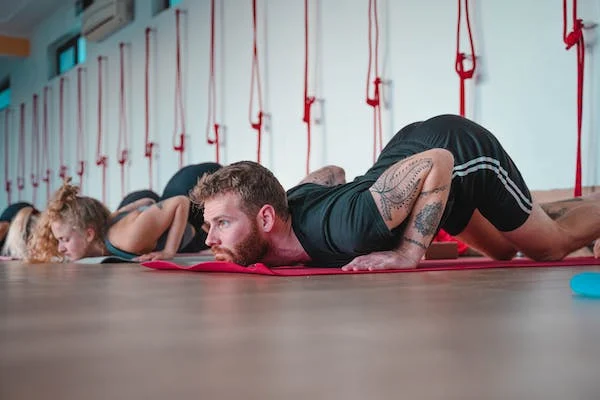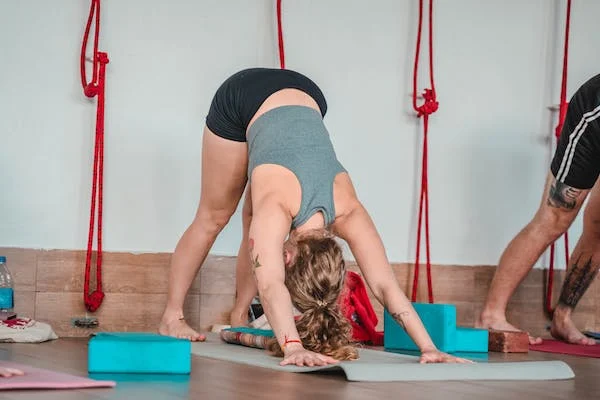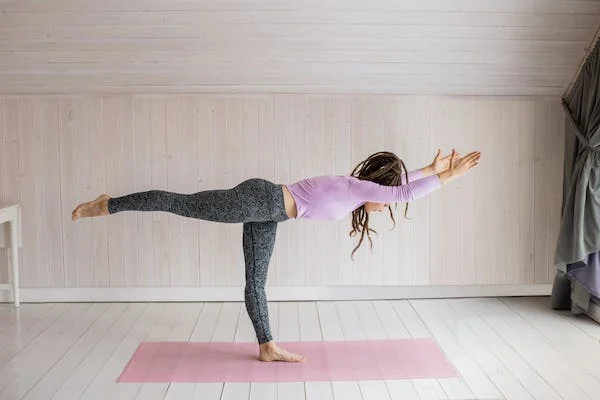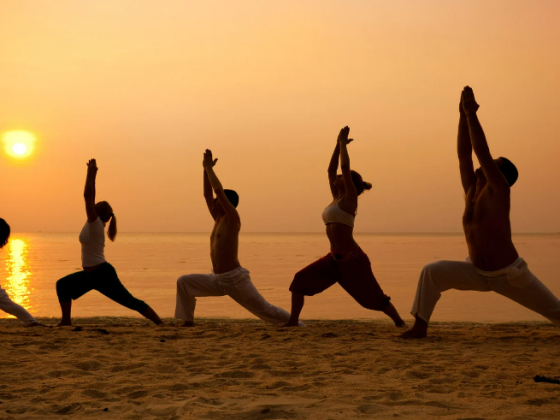
Yoga has transitioned from the traditional to various fusions and innovations. This leads to a more specified and intensified movement depending on the people’s needs. Yet, like any other yoga, yoga sculpt aims to revitalize and help people’s physical fitness. In this article, we will tackle the integration of yoga and another form of exercise, the yoga sculpt. Read to know more!
Understanding Yoga Sculpt:
What is Yoga Sculpt?
Yoga Sculpt blends power yoga and strength training to deliver a comprehensive full-body workout. This high-intensity session guarantees you’ll feel stronger, refreshed, and revitalized by blending traditional yoga postures and principles with strength training using hand weights.
Yoga Sculpt is an innovative fitness amalgamation. Picture yoga’s serene postures entwined with resistance training’s muscle-sculpting benefits and the pulsating intensity of high-intensity interval training (HIIT). This dynamic combination strengthens and tones the body and amplifies cardiovascular endurance, making it a comprehensive workout regimen.
Yoga Sculpt offers numerous benefits to your practice, including integrating cardio exercises and high-intensity interval training to promote heart health and calorie burning. Hand weights enhance lean muscle development and introduce fresh challenges to your routine.
Yoga sculpt classes have become increasingly popular, providing individuals with a holistic full-body workout regimen to improve overall fitness. Despite the classes occasionally resembling calorie-burning HIIT sessions, practitioners need not worry, as they seamlessly integrate traditional yoga poses and deep stretches, allowing for moments of inner calm amidst the intensity—from performing dumbbell rows to transitioning into Savasana promptly afterward.
Suitable for those who enjoy yoga as a form of exercise, yoga sculpting is particularly beneficial for intermediate-level practitioners. However, beginners may find incorporating resistance and speed into yoga poses challenging, which can test their balance and core strength.
Yoga body sculpts classes, unlike traditional yoga, draw inspiration from yoga practices while emphasizing strength training and cardio. Incorporating familiar poses like Downward-Facing Dog, these classes offer mental health benefits and physical conditioning. In contrast to slow-paced Yin or dynamic Vinyasa sessions, sculpt classes resemble fitness workouts with heightened energy levels, quicker pace, and high-tempo music, ideal for muscle-sculpting, calorie burning, and inducing sweat.
The Evolution of Yoga Sculpt
Yoga Sculpt comes to life when yoga meets muscle. Energize your metabolism and develop lean muscle mass to upbeat tracks. Combining free weights with CorePower Yoga 2 sequencing and cardio will elevate each pose while integrating strength-training movements like squats, lunges, and bicep curls.
This practice finds its roots in the ancient art of yoga. While yoga traditionally focuses on enhancing flexibility, balance, and mindfulness, Yoga Sculpt infuses these principles with a modern twist. It’s an evolution propelled by the need for a more holistic approach to fitness, emphasizing strength and endurance alongside the traditional benefits.
The Core Principles of Yoga Sculpt:
Fusion of Yoga and Strength Training
Yoga provides health and wellness benefits, yet its advantages are heightened when integrated with other fitness systems.
At the crux of Yoga Sculpt lies the fusion of contrasting yet complementary worlds. Fluid yoga poses meet the rigidity of weights and resistance bands, amalgamating grace and strength. The seamless integration of these practices creates a holistic approach to physical fitness.
Mind-Body Connection in Yoga Sculpt
The mind and the body are intricately linked; changes in one invariably influence the other. Our thoughts, feelings, beliefs, and attitudes significantly affect our overall biological well-being, positively or negatively. Undeniably, a profound mind-body connection exists, shaping our holistic health and functioning.
The essence of Yoga Sculpt extends beyond physical exercise. The narrative intertwines the breath, mind, and body in a movement symphony. It encourages practitioners to synchronize breath with motion, fostering a deeper connection to the present moment.
Our thoughts impact our emotions, influencing our thoughts, communication, and behavior. This intricate relationship between mind and body, known as the mind-body connection, elucidates how our physical and mental well-being are interlinked through communication between the mind and body.
Dr. James Gordon, the creator of the Center for Mind-Body Connection, emphasizes the shared “chemical language” among the body’s systems. He underscores that the brain, peripheral nervous, endocrine, immune, and all organs and emotional responses communicate via this common chemical language. Such interconnectedness underscores the holistic nature of human physiology.
Our nervous system, consisting of the central and peripheral components, serves as the body’s messaging system. Dr. James Gordon, the originator of the Center for Mind-Body Connection, integrates information, while the peripheral system, composed of branching nerves, facilitates communication throughout the body. This intricate network regulates responses, toggling between sympathetic and parasympathetic states to address threats and promote relaxation. Studies reveal that yogic practices like breathwork and asana strongly activate the parasympathetic nervous system via the vagus nerve, fostering resilience and emotional well-being. Nurturing ourselves with healthy habits strengthens this communication, enhancing our body’s capacity to adapt and thrive.

Getting Ready: Preparation Secrets
Mental Preparation
Yoga Sculpt extends beyond mere physical exertion; mental preparation is vital. Techniques like mindfulness and visualization play a crucial role in readying the mind for the challenges and rewards of the session ahead. Creating a space of mental clarity primes the body for the workout.
Physical Warm-Up
The significance of a comprehensive warm-up cannot be overstated. It’s the foundation for a safe and effective workout, reducing the risk of injury and ensuring optimal performance. It could involve dynamic stretches, light cardio, and yoga-based movements to awaken the body.
Equipment Essentials
To embark on a yoga-sculpting journey, a few tools are indispensable. The essential arsenal is a yoga mat, resistance bands, dumbbells, and a stability ball. These tools enhance the workout’s efficiency by enabling various movements to engage multiple muscle groups.
Techniques and Moves:
Yoga Asanas in Sculpting
Yoga Asana, conceived as a seated meditation posture, has recently evolved to encompass all physical yoga practices.
Traditional yoga poses take on a new dimension in Yoga Sculpt. Adding weights or resistance bands to poses like Warrior, Downward Dog, or Chair Pose intensifies muscle engagement, promoting strength and endurance while retaining the grace of yoga.
Incorporating High-Intensity Interval Training
HIIT elements, marked by short bursts of high-intensity exercises followed by brief recovery periods, inject a refreshing energy into the session. This elevates the heart rate and incinerates calories, contributing to the overall fitness quotient.
Breathwork and Focus
The synchronicity of breath and movement is a fundamental element in yoga sculpture. Coordinating inhales and exhales with each pose amplifies concentration, fostering a deeper mind-body connection. It’s not just about movement; it’s about harmonizing breath with motion.
Benefits of Yoga Sculpt
Yoga sculpting merges the advantages of traditional yoga and strength training, enhancing endurance and mobility. This practice tones muscles while fostering relaxation of the mind and regulation of the nervous system. Promoting body awareness strengthens bones and joints and enhances lung function.
Yoga sculpt classes offer a range of benefits, including enhanced muscle strength and tone, improved flexibility and range of motion, and boosted cardiovascular fitness. Moving mindfully through poses while coordinating breath regulation can help manage the nervous system, reducing anxiety and increasing feelings of calmness. With their higher tempo, yoga sculpt classes also present opportunities for increased sweat, calorie expenditure, and potential weight loss. Yet, weight loss is affected by many factors, such as regular exercise, diet, stress levels, and sleep quality. It’s recommended to utilize two sets of weights during practice: a lighter set for smaller muscle groups like biceps and a heavier set for larger ones like glutes and quads.
Physical Benefits
The tangible benefits of Yoga Sculpt span muscle toning, improved endurance, and a considerable calorie burn. The practice assists in sculpting lean muscle while enhancing overall stamina, offering a comprehensive physical overhaul.
Mental and Emotional Well-being
Beyond the physical realm, Yoga Sculpt’s impact extends to mental clarity, stress reduction, and emotional balance. The marriage of physical exertion with mindfulness techniques fosters a sense of calm and inner balance.
Yoga Sculpt Moves to Try as Beginners:
Explore these two beginner-friendly yoga sculpt exercises that we highly recommend. But before diving in, remember to warm up properly—a 7-minute yoga warm-up can set the tone for your practice. Now, let’s delve into the world of yoga sculpting.
-
Push-Ups
Push-ups enhance strength and muscle development in the pectorals, deltoids, triceps, and core. At the same time, Downward Dog stretches muscles throughout the body, focusing on the shoulders, arms, upper back, hamstrings, and calves.
-
High Planks
High Planks activate all major muscle groups, involving the shoulders, arms, chest, core, lower back, glutes, hips, and quads. Plank jacks intensify core activation and provide cardiovascular advantages, engaging the legs more extensively than a standard plank.
This exercise engages and fortifies the glutes, hamstrings, and lower back while focusing on the hip extensor muscles, all essential for maintaining good posture.

Challenges and Solutions:
Overcoming Resistance
For those new to Yoga Sculpt, the fusion of yoga and strength training might initially feel daunting. Gradual progression, instructor guidance, and a patient approach can help individuals surpass these hurdles.
Adapting to Intensity
The intensity of Yoga Sculpt might pose a challenge, especially for beginners. Gradually acclimating the body to this regimen and listening to one’s body are pivotal. Starting with lighter weights and shorter sessions can pave the way for a smoother transition.
Integrating Yoga Sculpt in Routine:
Frequency and Timing
The frequency of practice varies for each individual. However, aiming for a balanced routine with 2-3 sessions a week is often recommended. They find the optimal time during the day when optimal energy levels are vital for a fulfilling session.
Complementary Practices
Yoga Sculpt doesn’t have to exist in isolation. It can complement other workouts or forms of yoga, creating a versatile and balanced fitness regimen. Incorporating it with activities like Pilates or running can diversify the fitness routine.
Conclusion:
The world of Yoga Sculpt is a harmonious blend of ancient wisdom and modern fitness. It’s a pathway to sculpting the body while nurturing mental tranquility. Exploring this unique synthesis promises a sculpted physique and a journey toward inner peace and balance.




